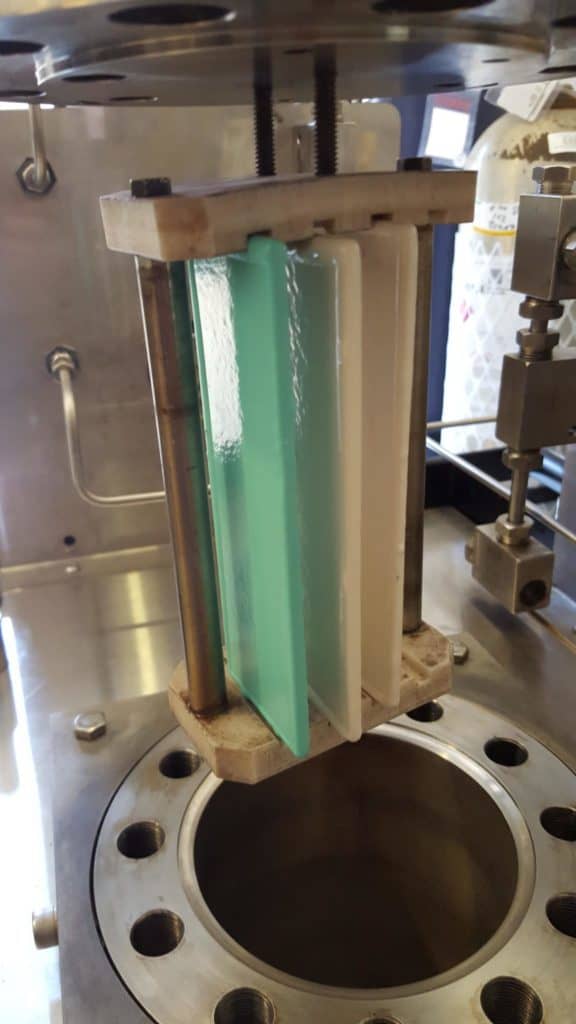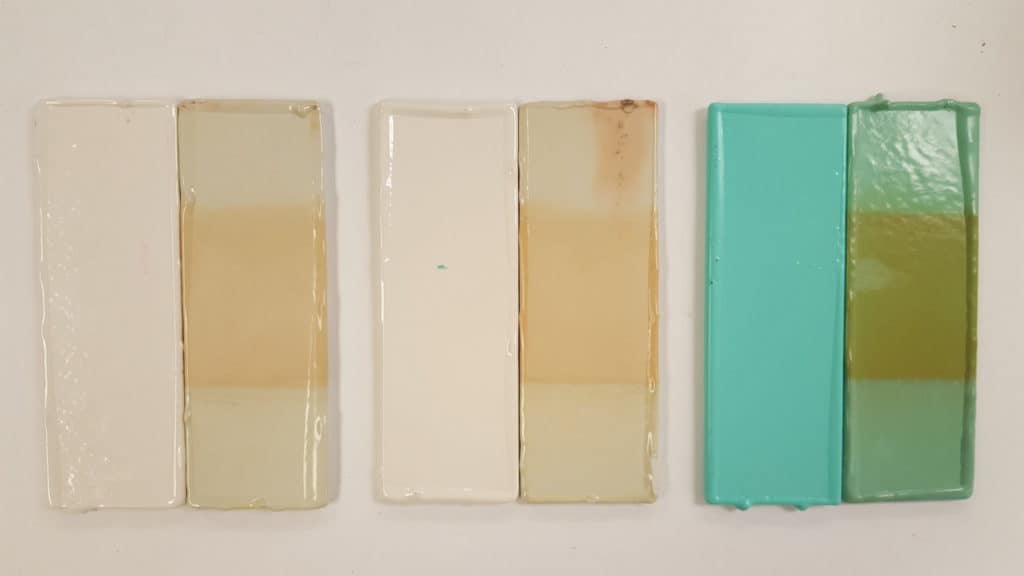Introduction
Industrial and marine protective coatings can provide decades of corrosion protection, provided the correct coating system is selected for the prevailing service environment, and that the coating system remains attached to the substrate it was designed to protect. Industrial coatings used in the water, wastewater, oil and gas, and nuclear power industries may be exposed to extreme high temperature and high-pressure conditions. Without prior knowledge of the coating system’s ability to perform under these conditions, there is greater risk of accelerated deterioration and catastrophic failure. If the coating system failure is undetected, section loss can occur, and structural integrity can become a concern. Laboratory testing, and subsequent evaluation of coating system performance can provide great insight as to how a coating/coating system will perform prior to large scale installation. Easier said than done. Simulating extreme temperatures and pressures requires specialized equipment with integral safeguards. This can be accomplished in a laboratory using an autoclave.
According to Wikipedia, an autoclave is a pressure chamber used to carry out industrial processes requiring elevated temperature and pressure different from ambient air pressure. Autoclaves are used in medical applications to perform sterilization and in the chemical industry to cure coatings, vulcanize rubber, and for hydrothermal synthesis. They are also used in industrial applications, especially regarding composites.
Many autoclaves are used to sterilize equipment and supplies by subjecting them to high-pressure saturated steam at 121 °C (249 °F) for 15 to 20 minutes depending on the size of the load and the contents. The autoclave was invented by Charles Chamberland in 1884, although a precursor known as the steam digester was created by Denis Papin in 1679. The name comes from Greek auto-, ultimately meaning self, and Latin clavis meaning key, thus a self-locking device.
Use of Autoclaves for Coating System Performance Testing
 Autoclave testing is a versatile process for assessing the performance properties of a coating or coating system that is being considered for use. It is designed to simulate many different service environments through wide temperature and pressure ranges and various test mediums. A typical test condition for an oil and gas application would consist of three phases: hydrocarbon, water, and gas. A typical test regime is to prepare test panels and apply the candidate coating/lining systems to all surfaces (sides and edges), measure for thickness and check for pinholes/holidays. Once the coating system has fully cured, the test panels are placed into the pressure vessel (autoclave). The simulated environment is then prepared with the appropriate test medium, temperature, and pressure. After the designated exposure period (ranging from 24-hours up to 30 days or longer), the vessel is cooled and depressurized, then the coated test panels are removed and examined for blistering, loss of adhesion or other defects.
Autoclave testing is a versatile process for assessing the performance properties of a coating or coating system that is being considered for use. It is designed to simulate many different service environments through wide temperature and pressure ranges and various test mediums. A typical test condition for an oil and gas application would consist of three phases: hydrocarbon, water, and gas. A typical test regime is to prepare test panels and apply the candidate coating/lining systems to all surfaces (sides and edges), measure for thickness and check for pinholes/holidays. Once the coating system has fully cured, the test panels are placed into the pressure vessel (autoclave). The simulated environment is then prepared with the appropriate test medium, temperature, and pressure. After the designated exposure period (ranging from 24-hours up to 30 days or longer), the vessel is cooled and depressurized, then the coated test panels are removed and examined for blistering, loss of adhesion or other defects.
The depressurization phase itself can also be a variable when performing testing in an autoclave (see KTA University article, Under Pressure: The Effects of Rapid Depressurization on Coating System Performance, June 2017). The depressurization phase can be customized to simulate a gradual, uniform rate of release or rapid depressurization. Depressurization is a key step in evaluating a coating’s performance. High pressure environments can cause the infiltration of gases into the coating, and depressurization will cause the gases to migrate to an equilibrium state. Blistering of the coating material can occur when the discharge of the gas is slower than the depressurization of the autoclave. This process can result in coating delamination and the corrosive gases attacking the unprotected substrate.
There are cases when high pressure is not necessary for testing. For example, the autoclave can be used to evaluate a coating system’s resistance to the effects of steam at high temperature. In the oil and gas sector, steam is used to remove residue from the sides of crude oil tanks prior to inspection. When testing for resistance to steam in an autoclave, prepared and coated test panels are placed in the vessel containing a small amount of water. High temperature is then used to produce steam and the coated panels are exposed for the predetermined time; generally 24-hours. Following exposure, the coating system can be visually examined for defects such as blistering, flaking, or cracking. Adhesion or other physical properties (pre- and post-exposure) can also be assessed if desired. These results can help predict how the coating or coating system will perform in the actual service environment.
Industry Test Methods
 Although autoclave testing is very customizable, there are standardized test methods that offer requirements and guidance for testing and evaluation. NACE TM0185 (described below) offers the flexibility to select specific conditions and offers guidance for evaluations, allowing the interested parties to customize testing to simulate actual conditions. Conversely, ISO 15741, Annex C (also described below) does not allow for customization to simulate a service environment, but instead has specific requirements. Either approach can be beneficial when comparing the performance of a series of candidate coating systems. Using a method like ISO 15741 with specific test parameters and testing conditions enables comparative performance of coatings that are tested at different times.
Although autoclave testing is very customizable, there are standardized test methods that offer requirements and guidance for testing and evaluation. NACE TM0185 (described below) offers the flexibility to select specific conditions and offers guidance for evaluations, allowing the interested parties to customize testing to simulate actual conditions. Conversely, ISO 15741, Annex C (also described below) does not allow for customization to simulate a service environment, but instead has specific requirements. Either approach can be beneficial when comparing the performance of a series of candidate coating systems. Using a method like ISO 15741 with specific test parameters and testing conditions enables comparative performance of coatings that are tested at different times.
NACE TM0185, “Evaluation of Internal Plastic Coatings for Corrosion Control of Tubular Goods by Autoclave Testing” indicates that hydrocarbon, water, and gas phases should be used at a coverage of at least 25% per phase, but allows for the phases, temperature, pressure, and length of exposure to be chosen to simulate the actual service environment. The depressurization phase in NACE TM0185 consists of reducing the temperature of the pressurized vessel to 200°F and releasing the pressure at a uniform rate so that it is back to atmospheric pressure in 15 to 30 minutes. Upon depressurization, several attributes within each liquid and gaseous phase (e.g., blistering, softening, adhesion, and porosity) can be assessed. It should be noted however, that a standard method for each evaluation is not provided by the NACE Test Method. Rather, the NACE method offers the flexibility to select specific conditions and provides guidance for evaluations, allowing the stakeholders to perform testing (or have testing performed for them) as they see fit and to determine coating performance expectations based on a needs assessment.
ISO 15741, “Paints and varnishes – Friction-reduction coatings for the interior of on- and offshore steel pipelines for non-corrosive gases,” Annex C, “Resistance to gas pressure variations” is more regimented than NACE TM0185. Testing performed according to ISO 15741, Annex C is designed to evaluate a coating’s resistance to cyclic pressurization. In this method, prepared and coated test panels are placed into a pressure vessel maintained at ambient temperature that is subsequently pressurized to 1,450 psi with nitrogen, and endure a rigorous 14-day sequence where the vessel is cyclically pressurized and rapidly depressurized within five minutes. Following the final cycle, the coated panels are removed and evaluated for visual changes, including corrosion, spots, and blisters, as well as adhesion performed according to ISO 2409, Paints and varnishes – Cross-cut Test.
Summary
Coating systems are used for corrosion protection in a wide variety of service environments. Some environments are quite severe and subject the installed coating systems to high temperature, high pressure, corrosive gases and liquids, and even rapid depressurization. Testing of candidate coating systems in an autoclave that is configured to simulate, as close as feasible actual conditions can help eliminate coating systems that are not compatible with the service environment and provide peace-of-mind that installed coating systems will perform as designed.



